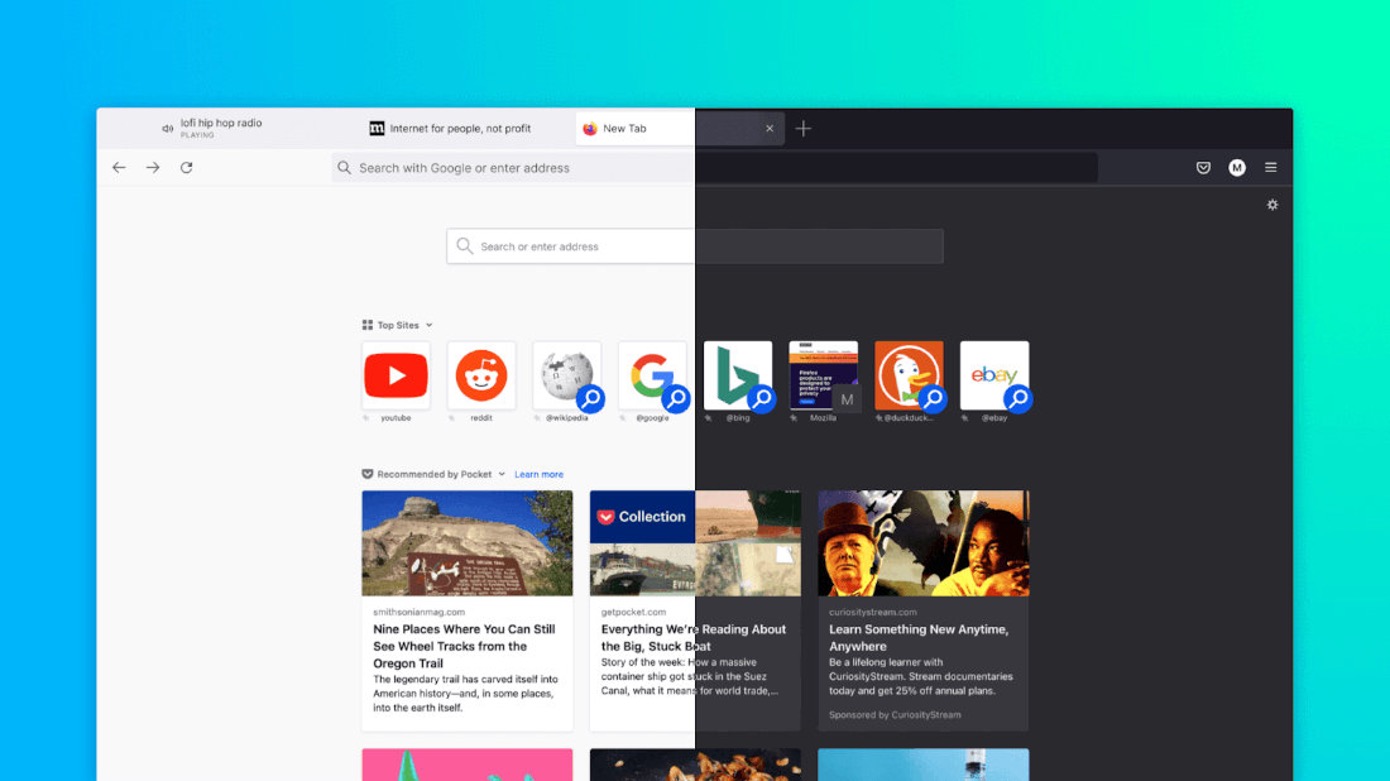Introduction
Are you a long-time user of Mozilla Firefox who misses the familiar look and feel of the older versions? Perhaps you've recently upgraded to a newer version of Firefox and find yourself yearning for the classic interface that you've grown accustomed to over the years. The good news is that you can bring back the nostalgic design elements and functionality of the old Firefox by customizing the new version to resemble its predecessor.
In this article, we'll explore how you can transform the appearance of the latest Firefox browser to closely resemble the beloved older versions. By following a few simple steps and utilizing the Classic Theme Restorer extension, you can bring back the familiar toolbar, menu bar, tab appearance, and status bar, effectively recreating the classic Firefox experience within the modern browser.
Whether you miss the traditional menu bar, prefer the classic tab style, or simply long for the comforting presence of the status bar, this guide will walk you through the process of reviving the classic Firefox look. By the end of this article, you'll have the knowledge and tools to customize your Firefox browser to reflect the aesthetics and functionality of the older versions, providing a sense of nostalgia and familiarity as you navigate the web.
So, if you're ready to embark on a journey to transform your new Firefox into a reminiscent version of the past, let's dive into the steps to install the Classic Theme Restorer extension and begin the process of reviving the classic Firefox look.
Installing Classic Theme Restorer
To begin the transformation of your new Firefox browser into a reminiscent version of the past, the first step is to install the Classic Theme Restorer extension. This powerful add-on serves as the gateway to customizing the browser's appearance and functionality, allowing you to bring back the classic elements that have defined the Firefox experience for many users.
-
Accessing the Add-ons Manager: Start by launching your Firefox browser and navigating to the menu icon located in the top-right corner of the window. Click on the icon to reveal the dropdown menu, then select "Add-ons" to access the Add-ons Manager.
-
Searching for Classic Theme Restorer: Within the Add-ons Manager, locate the search bar in the top-right corner of the page. Enter "Classic Theme Restorer" into the search field and press Enter to initiate the search.
-
Selecting and Installing the Extension: Once the search results appear, look for the Classic Theme Restorer extension in the list of available add-ons. When you find it, click on the "Add to Firefox" button next to the extension to begin the installation process.
-
Confirming the Installation: A confirmation dialog will appear, prompting you to confirm the installation of the Classic Theme Restorer extension. Click "Add" to proceed with the installation.
-
Restarting Firefox: After the installation is complete, Firefox will prompt you to restart the browser to enable the newly installed extension. Click on the "Restart Now" button to relaunch Firefox and activate the Classic Theme Restorer.
Once the browser restarts, the Classic Theme Restorer extension will be fully integrated into your Firefox browser, empowering you to embark on the journey of customizing the interface to resemble the classic look and feel of older Firefox versions. With the installation process complete, you are now ready to delve into the next steps of customizing the toolbar, restoring the menu bar, changing the tab appearance, and reviving the status bar, all of which will contribute to the transformation of your new Firefox into a familiar and nostalgic browsing experience.
Customizing the Toolbar
With the Classic Theme Restorer extension successfully installed, you can now embark on the exciting journey of customizing the toolbar in your new Firefox browser to resemble the classic interface that you fondly remember. The toolbar serves as a central hub for accessing essential browser functions and features, and by customizing it to align with the classic design, you can evoke a sense of nostalgia and familiarity as you navigate the web.
To begin customizing the toolbar, navigate to the menu icon in the top-right corner of the browser window and select "Customize" from the dropdown menu. This action will launch the customization mode, allowing you to modify the appearance and layout of the toolbar to suit your preferences.
In the customization mode, you'll have the flexibility to add, remove, and rearrange various elements on the toolbar. This includes buttons for functions such as back, forward, reload, home, and more. You can also incorporate additional features and extensions onto the toolbar to enhance your browsing experience.
One of the key features offered by the Classic Theme Restorer extension is the ability to restore the classic toolbar layout, which includes options for placing the navigation buttons, address bar, and search bar in their original positions. This feature enables you to recreate the familiar arrangement that characterized the older versions of Firefox, allowing you to feel right at home within the browser interface.
Furthermore, the customization mode provides the opportunity to adjust the size and spacing of toolbar icons, offering a level of personalization that caters to your visual preferences and ergonomic needs. Whether you prefer compact icons with minimal spacing or larger icons for improved visibility, the customization options empower you to tailor the toolbar to your liking.
As you make adjustments to the toolbar layout and appearance, take the time to experiment with different configurations and consider how each change contributes to the overall aesthetic and functionality of the browser. By leveraging the customization capabilities provided by the Classic Theme Restorer extension, you can transform the toolbar into a familiar and comforting interface that reflects the classic Firefox experience.
Once you are satisfied with the customized toolbar, simply click the "Done" button in the customization mode to apply your changes. Your new Firefox browser will now showcase a toolbar that closely resembles the classic design, complete with the familiar layout and functionality that defined the older versions of the beloved browser.
In the next section, we will explore the process of restoring the menu bar, further enhancing the nostalgic transformation of your new Firefox into a reminiscent version of the past.
Restoring the Menu Bar
Restoring the menu bar in your new Firefox browser is a pivotal step in the journey to recreate the classic look and feel of older versions. The menu bar, a fundamental element of the traditional Firefox interface, provides access to essential browser functions and features, serving as a familiar and convenient navigation tool for users.
To begin the process of restoring the menu bar, navigate to the menu icon in the top-right corner of the browser window and select "Customize" from the dropdown menu. This action will launch the customization mode, allowing you to modify the appearance and layout of the toolbar and access the option to restore the menu bar.
Within the customization mode, you'll find the "Title Bar" option, which, when selected, will reveal the "Menu Bar" checkbox. By checking this option, you can seamlessly restore the classic menu bar to its rightful place at the top of the browser window, evoking a sense of nostalgia and familiarity as you interact with the browser interface.
Once the menu bar is restored, you'll notice the return of familiar menu items such as "File," "Edit," "View," "History," "Bookmarks," "Tools," and "Help," each offering a range of functions and settings that have been integral to the Firefox experience over the years.
The restored menu bar not only contributes to the visual transformation of your new Firefox browser but also enhances the accessibility of essential browser features, providing a seamless and intuitive navigation experience reminiscent of the classic interface.
Furthermore, the restoration of the menu bar aligns with the overarching goal of reviving the classic Firefox look, creating a cohesive and nostalgic browsing environment that resonates with long-time users who have cherished the traditional design and functionality of the browser.
By leveraging the customization capabilities offered by the Classic Theme Restorer extension, you can effortlessly bring back the iconic menu bar, infusing your new Firefox with the timeless charm and familiarity of the older versions. This restoration process represents a significant milestone in the journey to transform your new Firefox into a reminiscent version of the past, setting the stage for a browsing experience that seamlessly blends modern capabilities with classic aesthetics.
With the menu bar successfully restored, your new Firefox browser now exudes the classic charm and functionality that defined the beloved older versions, paving the way for a nostalgic and enjoyable browsing experience that pays homage to the rich history of the Firefox browser.
In the next section, we will delve into the process of changing the tab appearance, further enhancing the nostalgic transformation of your new Firefox into a reminiscent version of the past.
Changing the Tab Appearance
Customizing the tab appearance in your new Firefox browser presents an exciting opportunity to infuse the interface with a touch of nostalgia while enhancing the visual appeal and functionality of the browsing experience. The tabs serve as essential navigational elements, allowing users to seamlessly switch between open webpages and manage their browsing sessions with ease. By modifying the tab appearance to align with the classic design, you can evoke a sense of familiarity and nostalgia as you interact with the browser interface.
With the Classic Theme Restorer extension at your disposal, the process of changing the tab appearance becomes a seamless and intuitive endeavor. Begin by navigating to the menu icon in the top-right corner of the browser window and selecting "Customize" from the dropdown menu. This action will launch the customization mode, providing you with the tools to modify the appearance and layout of the browser interface, including the tab configuration.
Within the customization mode, you'll have the flexibility to adjust various aspects of the tab appearance, such as the tab shape, color, and overall style. The Classic Theme Restorer extension offers a range of options for customizing the tab appearance, allowing you to tailor the design to closely resemble the classic tab style that characterized the older versions of Firefox.
One of the key features provided by the Classic Theme Restorer is the ability to restore the squared tab shape, reminiscent of the classic Firefox design. This option allows you to deviate from the default curved tab style found in the newer versions, bringing back the familiar squared tabs that have been a hallmark of the traditional Firefox interface.
Additionally, the extension offers customization options for tab colors, enabling you to personalize the appearance of active and inactive tabs to suit your visual preferences. Whether you prefer vibrant colors for active tabs or subdued tones for inactive ones, the customization capabilities empower you to create a tab appearance that resonates with your aesthetic sensibilities.
By leveraging the customization features offered by the Classic Theme Restorer, you can transform the tab appearance in your new Firefox browser to reflect the classic design elements that have defined the browsing experience for many users. The restored tab appearance not only contributes to the visual transformation of the interface but also evokes a sense of nostalgia and familiarity, creating a cohesive and immersive browsing environment that pays homage to the timeless charm of the older Firefox versions.
Once you've finalized the changes to the tab appearance, simply click the "Done" button in the customization mode to apply your modifications. Your new Firefox browser will now showcase a tab configuration that closely resembles the classic design, complete with squared tabs and personalized colors that capture the essence of the beloved older versions.
In the next section, we will explore the process of restoring the status bar, further enhancing the nostalgic transformation of your new Firefox into a reminiscent version of the past.
Restoring the Status Bar
Restoring the status bar in your new Firefox browser represents a pivotal step in the journey to recreate the classic look and feel of older versions. The status bar, a quintessential component of the traditional Firefox interface, serves as a dynamic information hub, providing users with essential details about webpage loading progress, link destinations, and other pertinent browser activities.
To initiate the process of restoring the status bar, begin by accessing the menu icon in the top-right corner of the browser window and selecting "Customize" from the dropdown menu. This action will transition the browser into customization mode, granting you the ability to modify the appearance and layout of the interface, including the restoration of the status bar.
Within the customization mode, you'll encounter the option to restore the status bar, which can be achieved by locating the "Status Bar" checkbox and selecting it to enable the restoration. Once activated, the status bar will reappear at the bottom of the browser window, reinstating its role as a valuable source of real-time information and feedback during browsing sessions.
The restored status bar will display essential details such as link destinations, loading progress indicators, and security notifications, offering users a comprehensive view of the browser's activities and interactions with web content. This reinstatement not only contributes to the visual transformation of your new Firefox browser but also enhances the functionality and user experience, aligning with the nostalgic design elements that have defined the Firefox interface over the years.
Furthermore, the restoration of the status bar aligns with the overarching goal of reviving the classic Firefox look, creating a cohesive and immersive browsing environment that resonates with long-time users who have cherished the traditional design and functionality of the browser. By leveraging the customization capabilities offered by the Classic Theme Restorer extension, you can effortlessly bring back the iconic status bar, infusing your new Firefox with the timeless charm and familiarity of the older versions.
With the status bar successfully restored, your new Firefox browser now exudes the classic charm and functionality that defined the beloved older versions, paving the way for a nostalgic and enjoyable browsing experience that pays homage to the rich history of the Firefox browser.
In the next section, we will delve into the process of personalizing the browser's appearance and functionality, further enhancing the nostalgic transformation of your new Firefox into a reminiscent version of the past.
Conclusion
In conclusion, the journey to transform your new Firefox browser into a reminiscent version of the past has been a rewarding and nostalgic experience. By leveraging the Classic Theme Restorer extension and customizing the interface to reflect the classic design elements and functionality of older Firefox versions, you have successfully recreated a browsing environment that resonates with the timeless charm and familiarity of the beloved browser's history.
Through the installation of the Classic Theme Restorer extension, you gained the ability to restore the classic toolbar layout, bringing back the familiar arrangement of navigation buttons, address bar, and search bar. This customization not only evoked a sense of nostalgia but also provided a seamless transition for long-time users who have cherished the traditional Firefox interface.
The restoration of the menu bar further enhanced the nostalgic transformation, reintroducing familiar menu items and essential browser functions that have been integral to the Firefox experience over the years. The return of the iconic menu bar not only contributed to the visual transformation of the browser but also enhanced the accessibility of essential features, creating a cohesive and intuitive navigation experience reminiscent of the classic interface.
By customizing the tab appearance to reflect the classic design elements, you infused the interface with a touch of nostalgia while enhancing the visual appeal and functionality of the browsing experience. The restored squared tab shape and personalized colors captured the essence of the older Firefox versions, creating a tab configuration that resonates with the aesthetic sensibilities of long-time users.
The restoration of the status bar served as a pivotal step in the journey, reinstating its role as a valuable source of real-time information and feedback during browsing sessions. This reinstatement not only contributed to the visual transformation of the interface but also enhanced the functionality and user experience, aligning with the nostalgic design elements that have defined the Firefox interface over the years.
In essence, the process of customizing your new Firefox browser to resemble the classic look and feel of older versions has not only evoked a sense of nostalgia and familiarity but also paid homage to the rich history of the Firefox browser. As you navigate the web within this customized environment, you can relish in the seamless blend of modern capabilities and classic aesthetics, creating a browsing experience that transcends time and resonates with the enduring legacy of Firefox.

























